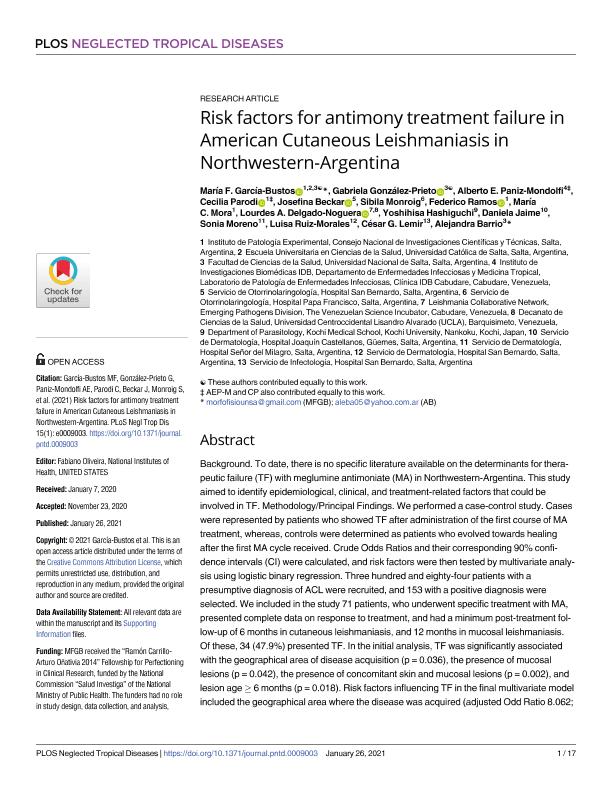Artículo
Risk factors for antimony treatment failure in American Cutaneous Leishmaniasis in Northwestern-Argentina
Garcia Bustos, Maria Fernanda ; González Prieto, Ana Gabriela
; González Prieto, Ana Gabriela ; Pániz Mondolfi, Alberto E.; Parodi Ramoneda, Cecilia María
; Pániz Mondolfi, Alberto E.; Parodi Ramoneda, Cecilia María ; Beckar, Josefina; Monroig, Sibila; Ramos, Federico
; Beckar, Josefina; Monroig, Sibila; Ramos, Federico ; Mora, Maria Celia
; Mora, Maria Celia ; Delgado Noguera, Lourdes A.; Hashiguchi, Yoshihisa; Jaime, Daniela; Moreno, Sonia; Ruiz Morales, Luisa; Lemir, César G.; Barrio, Alejandra; Oliveira, Fabiano
; Delgado Noguera, Lourdes A.; Hashiguchi, Yoshihisa; Jaime, Daniela; Moreno, Sonia; Ruiz Morales, Luisa; Lemir, César G.; Barrio, Alejandra; Oliveira, Fabiano
 ; González Prieto, Ana Gabriela
; González Prieto, Ana Gabriela ; Pániz Mondolfi, Alberto E.; Parodi Ramoneda, Cecilia María
; Pániz Mondolfi, Alberto E.; Parodi Ramoneda, Cecilia María ; Beckar, Josefina; Monroig, Sibila; Ramos, Federico
; Beckar, Josefina; Monroig, Sibila; Ramos, Federico ; Mora, Maria Celia
; Mora, Maria Celia ; Delgado Noguera, Lourdes A.; Hashiguchi, Yoshihisa; Jaime, Daniela; Moreno, Sonia; Ruiz Morales, Luisa; Lemir, César G.; Barrio, Alejandra; Oliveira, Fabiano
; Delgado Noguera, Lourdes A.; Hashiguchi, Yoshihisa; Jaime, Daniela; Moreno, Sonia; Ruiz Morales, Luisa; Lemir, César G.; Barrio, Alejandra; Oliveira, Fabiano
Fecha de publicación:
26/01/2021
Editorial:
Public Library of Science
Revista:
Neglected Tropical Diseases
ISSN:
1935-2735
Idioma:
Inglés
Tipo de recurso:
Artículo publicado
Clasificación temática:
Resumen
Background. To date, there is no specific literature available on the determinants for therapeutic failure (TF) with meglumine antimoniate (MA) in Northwestern-Argentina. This study aimed to identify epidemiological, clinical, and treatment-related factors that could be involved in TF. Methodology/Principal Findings. We performed a case-control study. Cases were represented by patients who showed TF after administration of the first course of MA treatment, whereas, controls were determined as patients who evolved towards healing after the first MA cycle received. Crude Odds Ratios and their corresponding 90% confidence intervals (CI) were calculated, and risk factors were then tested by multivariate analysis using logistic binary regression. Three hundred and eighty-four patients with a presumptive diagnosis of ACL were recruited, and 153 with a positive diagnosis were selected. We included in the study 71 patients, who underwent specific treatment with MA, presented complete data on response to treatment, and had a minimum post-treatment follow- up of 6 months in cutaneous leishmaniasis, and 12 months in mucosal leishmaniasis. Of these, 34 (47.9%) presented TF. In the initial analysis, TF was significantly associated with the geographical area of disease acquisition (p = 0.036), the presence of mucosal lesions (p = 0.042), the presence of concomitant skin and mucosal lesions (p = 0.002), and lesion age ≥ 6 months (p = 0.018). Risk factors influencing TF in the final multivariate model included the geographical area where the disease was acquired (adjusted Odd Ratio 8.062; 95% CI 1.914-33.959; p = 0.004), and lesion age ≥ 6 months (adjusted Odd Ratio 10.037; 95% CI 1.383-72.843; p = 0.023). Conclusions/Significance. The results of the present study suggest the existence of some risk factors linked to TF in Northwestern-Argentina, which deserve further investigation. Herein we recorded a high percentage of TF and we described clinical and epidemiological characteristics associated with TF that could be taken into account improving the clinical management of patients. Cutaneous leishmaniasis and mucosal leishmaniasis are parasitic diseases characterized by the involvement of skin and mucous membranes, respectively. The first-line drug for the treatment is meglumine antimoniate, but its use presents several limitations, such as an aggressive administration schedule, a wide range of local and systemic side effects, great variability in therapeutic response, and an important number of failed treatments. In this study, we explored epidemiological, clinical, and treatment-related factors that could be involved in treatment failure (TF). We included in the study 71 adult subjects who underwent the first cycle of specific treatment with meglumine antimoniate, and we found that the geographical area where the disease was acquired (Yungas ecoregion), and lesion age ≥ 6 months accounted as risk factors for TF. Knowledge of the high percentage of TF recorded, as well as a description of distinct characteristics associated with these failures, could help to improve the clinical management of patients.
Archivos asociados
Licencia
Identificadores
Colecciones
Articulos(IPE)
Articulos de INST.DE PATOLOGIA EXPERIMENTAL
Articulos de INST.DE PATOLOGIA EXPERIMENTAL
Citación
Garcia Bustos, Maria Fernanda; González Prieto, Ana Gabriela; Pániz Mondolfi, Alberto E.; Parodi Ramoneda, Cecilia María; Beckar, Josefina; et al.; Risk factors for antimony treatment failure in American Cutaneous Leishmaniasis in Northwestern-Argentina; Public Library of Science; Neglected Tropical Diseases; 15; 1; 26-1-2021; 1-17
Compartir
Altmétricas



